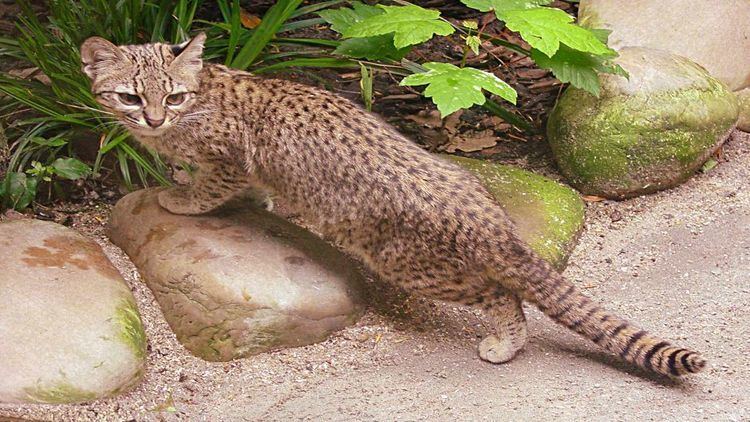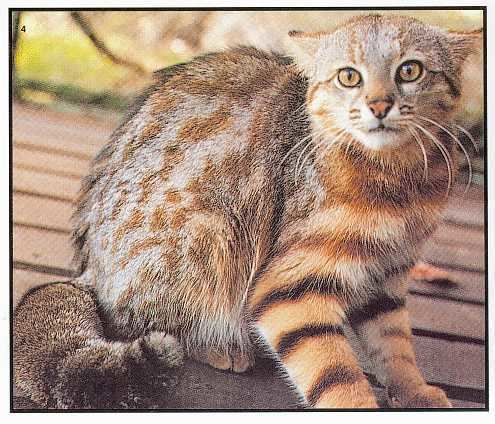Kingdom Animalia Order Carnivora Genus Leopardus Higher classification Leopardus | Phylum Chordata Family Felidae Scientific name Leopardus colocolo Rank Species | |
 | ||
Similar Pampas cat, Leopardus, Felidae, Kodkod, Geoffroy's cat | ||
The colocolo (Leopardus colocolo) is a small spotted and striped cat native to the west Andean slope in central and northern Chile. Until recently, it included the more widespread Pampas cat (L. pajeros) and Pantanal cat (L. braccatus), and some maintain these as subspecies of the colocolo. Confusingly, when these are treated as subspecies of the colocolo, the "combined" species is sometimes referred to as the Pampas cat.
Contents
- El gato colocolo
- Genus
- Species and subspecies
- Characteristics
- Distribution and habitat
- Ecology and behaviour
- Status
- References

El gato colocolo
Genus

Like most other small cats, the colocolo was formerly included in the genus Felis, but together with Geoffroy's cat and the kodkod, some have placed it in Oncifelis instead. Today, all major authorities place it in Leopardus.
Species and subspecies

As traditionally defined, the colocolo occurs in the widest range of habitats of any small South American felid. This, combined with distinct differences in pelage colour/pattern and cranial measurements, was the basis for splitting the Pantanal cat and Pampas cat from the colocolo. Based on genetic divergence, the splits within the colocolo group are estimated to have occurred about 1.7 million years ago (Mya). This divergence was lower than that found within Geoffroy's cat (about 2 Mya) or the oncilla (about 3.7 Mya; this very high divergence –far higher than other species in the genus– has resulted in some suggesting more than one species is involved in the oncilla). Furthermore, the distribution pattern within the colocolo group based on genetics did not completely match that based on pelage colour/pattern and cranial measurements, and supported some of the traditional subspecific division rather than species division. While the population in northern Chile has been placed in L. colocolo based on cranial measurements, genetics associate it with Pampas cats from Bolivia, and while the population in western Argentina has been placed in the Pampas cat based on pelage colour/pattern and cranial measurements, genetics associate it with the colocolo. More recent genetic analysis also supports maintaining the Pantanal and Pampas cats as subspecies of the colocolo.

When the Pantanal and Pampas cats are treated as a separate species, the colocolo has two subspecies: L. c. colocolo and L. c. wolffsohni.
Characteristics
The colocolo is a small, but heavy-set cat, only 56 to 67 cm (22 to 26 in) in body length, with a short 29 to 32 cm (11 to 13 in) tail, and weighing around 3 kg (6.6 lb) on average. The two subspecies differ in their pelage colour and pattern:
Externally, the colocolo differs from the Pantanal cat in its larger size, and pelage colour and pattern. Some Pampas cats are as large as the colocolo, and some subspecies of the Pampas cats have the same pelage colour and pattern as colocolos of the subspecies L. c. wolffsohni.
Distribution and habitat
The colocolo ranges throughout most of Argentina and Uruguay into the chaco and cerrado of Bolivia, Paraguay and Brazil, and north through the Andes mountain chain through Ecuador and possibly marginally into southwestern Colombia.
In 2016, it has been recorded for the time in the Sechura Desert and in dry forest of northwestern Peru.
Ecology and behaviour
Little is known about the colocolo's hunting and breeding habits. It is thought to prey mainly on small mammals and birds. Guinea pigs are thought to form a large part of its diet, along with viscachas and other rodents, and tinamous. Though some have suggested it is chiefly nocturnal, others suggest it is mainly diurnal.
Litters are relatively small, usually consisting of only one or two kittens, and occasionally three. The kittens weigh around 130 g (4.6 oz) at birth. The average lifespan is nine years, but some have lived for over 16 years.
Status
The IUCN has only rated the "combined" species (including Pantanal and Pampas cats), in which case the colocolo is considered Near Threatened. Whether the colocolo will receive a higher rating if the Pantanal and Pampas cats are treated as separate species is unclear, but it may be Endangered, and its range is smaller than that of the kodkod, rated as Vulnerable by the IUCN. However, unlike the kodkod, the colocolo is not associated with the highly threatened temperate rainforests found in the region.
